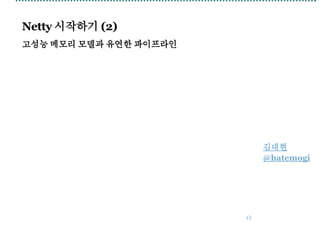Netty ل„‰ل…µل„Œل…،ل†¨ل„’ل…،ل„€ل…µ (2)
- 5. ReferenceCounted 별ëڈ„آ ë©”ëھ¨ë¦¬آ ي’€ى—گى„œآ ي• 당آ /آ ي•´ى œ ىµœى´ˆىکآ ى°¸ى،°ىˆک(refCnt)ëٹ”آ "1" ëچ”آ ى°¸ى،°ي•کëٹ”آ ê°ى²´ê°€آ ىƒê¸°ë©´آ retain()آ يک¸ى¶œآ آ>آ 1ى¦ê°€ ê°ى²´ë¥¼آ 다آ ىچ¼ىœ¼ë©´آ release()آ يک¸ى¶œآ آ>آ 1ê°گى†Œ ى°¸ى،°ىˆکê°€آ 0ى´ëگکë©´آ ë©”ëھ¨ë¦¬آ ي•´ى œ publicinterfaceReferenceCounted{ intrefCnt(); ReferenceCountedretain(); booleanrelease(); }
- 6. retain()آ /آ release()آ ى •ى±… ى¦‰,آ ى–´ë–¤آ ë©”ى†Œë“œآ voidA(ReferenceCountedobj)ê°€ 1.آ 다른آ ë©”ى†Œë“œآ B(obj)를آ يک¸ى¶œي•کëٹ”آ ê²½ىڑ° ë©”ى†Œë“œآ A(obj)ى—گى„œëٹ”آ release()ي• آ ي•„ىڑ”آ ى—†ë‹¤ ë©”ى†Œë“œآ Bىکآ ى±…ى„آ (orآ ê·¸آ 다ىŒآ ى–´ë”کê°€) 2.آ obj를آ ىکآ ى“°ê³ ,آ 별다른آ ë©”ى†Œë“œآ يک¸ى¶œى´آ ى—†ى´آ ëپ난다 obj.release()를آ يک¸ى¶œآ ي•´ى•¼ي•¨! 마ى§€ë§‰ى—گآ ى‚¬ىڑ©ي•کëٹ”آ ë©”ى†Œë“œê°€آ release()ي•œë‹¤
- 12. ى±„ë„گآ يŒŒى´ي”„ë¼ى¸ىکآ ي™œىڑ© ê°پê°پىکآ ى±„ë„گى—گëٹ”آ ChannelPipelineى´آ ىˆê³ ي•œآ ChannelPipelineى—گëٹ”آ ChannelHandlerآ ى—¬ëں¬ê°œ ChannelPipelineى—گآ ى—¬ëں¬آ ChannelHandler를آ 다ى–‘ي•ک게آ ى،°ë¦½ي•´آ ى‚¬ىڑ©
- 13. Channel ى½ê¸°,آ ى“°ê¸°,آ ى—°ê²°(connect),آ ë°”ى¸ë“œ(bind)등ىکآ I/Oآ ى‘ى—…ى„آ ي• آ ىˆکآ ىˆëٹ”آ ىڑ”ى†Œآ ëکگ ëٹ”آ 네يٹ¸ى›Œيپ¬آ ى—°ê²° ëھ¨ë“ آ I/Oآ ى‘ى—…ى€آ 비ëڈ™ê¸°آ آ>آ ChannelFuture ي•µى‹¬آ ë©”ى†Œë“œ ChannelFutureaddListener(GenericFutureListener<...>listener) Channel channel() boolean isSuccess(); Throwable cause(); ChannelFutureawait() ChannelFuturesync()
- 25. test/nettystartup/h2/http/HttpStaticFileHandler.java publicclassHttpStaticFileHandlerextendsSimpleChannelInboundHandler<HttpRequest>{ privateStringpath; privateStringfilename; publicHttpStaticFileHandler(Stringpath,Stringfilename){ super(false);//setauto-releasetofalse this.path=path; this.filename=filename; } @Override protectedvoidchannelRead0(ChannelHandlerContextctx,HttpRequestreq)throwsException{ //TODO:[ى‹¤ىٹµ2-1]sendStaticFileë©”ى†Œë“œë¥¼ ىچ¨ى„œ 구يک„ي•©ë‹ˆë‹¤."/"ىڑ”ى²ى´ ى•„ë‹Œ ê²½ىڑ°ى—گëٹ” ى–´ë–»ê²Œ ي• 까ىڑ”? } privatevoidsendStaticFile(ChannelHandlerContextctx,HttpRequestreq)throwsIOException{ ... } }
























![test/nettystartup/h2/http/HttpStaticServer.java
publicclassHttpStaticServer{
staticStringindex=System.getProperty("user.dir")+"/res/h2/index.html";
publicstaticvoidmain(String[]args)throwsException{
NettyStartupUtil.runServer(8020,newChannelInitializer<SocketChannel>(){
@Override
publicvoidinitChannel(SocketChannelch){
ChannelPipelinep=ch.pipeline();
p.addLast(newHttpServerCodec());
p.addLast(newHttpObjectAggregator(65536));
p.addLast(newHttpStaticFileHandler("/",index));
//TODO:[ى‹¤ىٹµ2-2]HttpNotFoundHandler를 ىچ¨ى„œ 404ى‘답ى„ ى²ک리ي•©ë‹ˆë‹¤.
}
});
}
}](https://image.slidesharecdn.com/netty2-150331032508-conversion-gate01/85/Netty-2-24-320.jpg)
![test/nettystartup/h2/http/HttpStaticFileHandler.java
publicclassHttpStaticFileHandlerextendsSimpleChannelInboundHandler<HttpRequest>{
privateStringpath;
privateStringfilename;
publicHttpStaticFileHandler(Stringpath,Stringfilename){
super(false);//setauto-releasetofalse
this.path=path;
this.filename=filename;
}
@Override
protectedvoidchannelRead0(ChannelHandlerContextctx,HttpRequestreq)throwsException{
//TODO:[ى‹¤ىٹµ2-1]sendStaticFileë©”ى†Œë“œë¥¼ ىچ¨ى„œ 구يک„ي•©ë‹ˆë‹¤."/"ىڑ”ى²ى´ ى•„ë‹Œ ê²½ىڑ°ى—گëٹ” ى–´ë–»ê²Œ ي• 까ىڑ”?
}
privatevoidsendStaticFile(ChannelHandlerContextctx,HttpRequestreq)throwsIOException{
...
}
}](https://image.slidesharecdn.com/netty2-150331032508-conversion-gate01/85/Netty-2-25-320.jpg)


